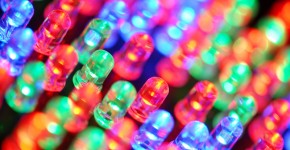Light emitting diodes (LED’s) are based on lighting technology that uses the electroluminescence of various semiconductor materials. The phenomenon of electroluminescence happens when an electric current passes through a semiconductor causing it to emit light. This the basic idea how light emitting diode technology works.
Electron holes
As the current passes through the semiconductor, electrons in the outer shells of its atoms become excited and jump to different positions leaving a hole – an electron hole – in the original atom. Semiconductors such as silicon and germanium can be processed – or doped – in a laboratory to produce and control a certain number and pattern of electron holes.
Doping in electronics jargon is the process of adding another element on a molecular scale, to the semiconductor to produce a change in its physical and chemical properties. It can be refined enough to produce two different types of semiconductor in the same original crystal.
P-n junctions
The junction between the two semiconductor types within the crystal is called the p-n junction. It allows the electric current to pass through it only in one direction. As the current passes from one semiconductor type to the other, excited electrons fill various empty electron holes. In the process they emit energy in the form of light. This is the light seen on the LED whether it is the light of a small indicator on a screen or dashboard, in a torch, or on a large scale as in LED floodlights. It is also the process by which semiconductor lasers work.

Colour production
Different colours of LED lights are produced by a variety of semiconductor elements and compounds:
• Gallium arsenide produces light in the infrared wavelengths
• Aluminium gallium arsenide produces infrared and red lights
• Gallium arsenide phosphide produces red, orange and yellow lights
• Aluminium gallium indium phosphide produces red, orange, yellow and green lights
• Gallium (III) phosphide produces red, orange, yellow and green lights
• Indium gallium nitride produces pure green, blue and violet lights
• Gallium (III) nitride produces a pure green light
• Silicon carbide when used as a substrate produces a blue light
• Zinc selenide produces a blue light
• Pure silicon when used as a substrate produces a blue light although this technology is still under development
• Diamond, boron nitride, aluminium nitride, aluminium gallium nitride and aluminium gallium indium nitride produce ultraviolet light
• Phosphorous is a common material for LED lights. Blue phosphorous with an added layer of yellow, red, orange or pink phosphorous added afterwards produces a pink light. White phosphorous combined with a pink pigment layer on top will also produce a pink light.
Mixing LEDs to produce white light
White LED lights are produced by a complex mixing process. Orange light from one LED device is mixed with complementary lights to produce white. (In light, the primary colours are red, blue and green that together will mix to produce white light). However, the best method to date is to use light from a blue or ultraviolet-producing LED and mix or coat it with yellow phosphorous ( green and red light produce yellow) to produce the white.
Image Courtesy : Free Digital Photos




